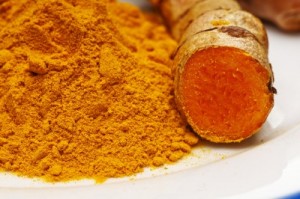By Sayer Ji
Contributing writer for Wake Up World
Millions take non-steroidal anti-inflammatory drugs (NSAIDs) daily for arthritis and related inflammatory conditions, but are completely unaware that far safer, and at least as effective, natural alternatives already exist — and are as easily accessible and inexpensive as the spices found in your kitchen cupboard.
Human research on the health benefits of turmeric is sparse, mainly due to the lack of capital available to fund expensive clinical trials.[i] Despite many decades of investigation as a lead drug compound, and the availability of thousands of preclinical studies indicating turmeric’s therapeutic value, few yet realize that this common kitchen spice may provide a suitable drug alternative for common health conditions.
[pro_ad_display_adzone id=”110028″]
The latest human study to clinically confirm turmeric’s medicinal value was published in the Indonesian Journal of Internal Medicine in April, 2012 and found the curcuminoid extract of turmeric was able to reduce inflammation in patients suffering from knee osteoarthritis.
Researchers compared the effect of a curcuminoid extract to the NSAID drug diclofenac sodium in reducing cycloxygenase -2 (COX-2) secretion by synovial fluid’s monocytes in two, randomly divided, groups suffering with knee osteoarthritis.
The synovial fluid is an egg yolk-like liquid within the cavities of the synovial joints, which serves to reduce friction between articular cartilage during movement. In knee osteoarthritis, a condition that afflicts 1 in 2 people by the age of 85 years, the immune cells known as monocytes express increased inflammatory COX-2 enzyme activity within the synovial fluid.
In the study, subjects were given either 30 mg 3 times daily of turmeric extract (curcuminoid) or 25 mg 3 times daily of diclofenac sodium for 4 weeks. After the treatment period, aspiration of the joint as performed and the secretion of cycloxygenase-2 enzyme by synovial fluid’s monocytes was evaluated.
Results were reported as follows:
In curcuminoid group the average scores were 1.84 ±0.37 and 1.15 ±0.28 respectively (p<0.001). In diclofenac group the average scores were 1.79 ±0.38 and 1.12 ±0.27 respectively (p<0.001). In curcuminoid group the decreasing score of cycloxygenase-2 secretion was 0.70 ±0.51 while in diclofenac group was 0.67 ±0.45. There was no significant difference in decreasing the score of cycloxygenase enzyme secretion between both treatment groups (p=0.89).
In summary, both curcuminoid and diclofenac sodium were capable of significantly decreasing the secretion of the inflammatory COX-2 enzyme, with nearly identical potency.
Discussion
This is not the first human study to confirm turmeric is at least as effective as an NSAID drug in reducing the symptoms associated with knee osteoarthritis. A 2010 study published in the Journal of Alternative and Complementary Medicine found 2,000 mg of turmeric extract was as effective as 800 mg of ibuprofen in reducing symptoms of pain and inflammation.[ii]
What is most remarkable about the more recent study is not that turmeric curcuminoids have potent anti-inflammatory properties – there are already hundreds of studies confirming its COX-2 reducing and otherwise anti-inflammary effects — but rather how much safer they are relative to NSAID drugs like diclofenac, which like most pharmaceutical anti-inflammatory drugs have been linked to adverse health effects such as increased cardiac mortality, miscarriage and seizure.
One way to assess the relative toxicity of these two compounds is to compare the primary polyphenol in turmeric, curcumin, with diclofenac sodium through their respective Material Safety Data Sheets, which contain detailed information on the toxicity of these substances.
Diclofenac Sodium: The LD50 for mice is 95 mg/kg, meaning that it only takes 95 mg/kg of mouse to acutely kill 50% of an exposed group.
Curcumin: The LD50 for mice is >2,000 mg/kg, meaning that it would take more than 2,000 mg/kg of mouse to acutely kill 50% of an exposed group.
In order to get perspective on how toxic an LD50 of 95 mg/kg is, let’s first calculate how much of this chemical it would take in milligrams to kill an average sized mouse. Mice are between 15-27 grams, depending on their age, strain and diet. If we take the average between the two, at 21 grams, our mouse would weigh 0.021 kilograms. This means that it only takes 1.9 milligrams to acutely kill 50% of the mice given such a dose.
Extrapolating to humans, an average 150 lb adult weighs 68.03 kilograms, it would only take 6462 milligrams, or 6.46 grams to kill 50% of the humans given the dose. This is less than the weight of three pennies (7.5 grams). Compare this to the LD50 of curcumin (2,000 mg/kg), where it would take more than 136,000 mgs (4.86 ounces) to kill 50% of the humans given it – and even this estimation is doubtful, since it is likely that it would simply be vomited up, or expelled through the gastrointestinal tract, and other organs of elimination, before reaching lethal levels in the body. Also, remember that it only took 90 mg a day in the aforementioned study to reduce inflammation as effectively as diclofenac sodium. The difference between the 90 mg required to produce an effective response, and a (theoretical) 136,000 mg threshold for lethal toxicity, is four orders of magnitude.
In practical terms, the chance of you hurting yourself with a drug like diclofenac sodium — ironically, in an attempt to reduce pain — as compared to a simple kitchen spice like turmeric, is infinitely higher. Consider too, that there are over 100 known adverse health effects associated with this chemical class of drugs, whereas turmeric (and curcumin) has been linked to over 600 beneficial ones — not exactly a hard choice to make, when it comes to risk-benefit analysis.
For additional research on natural alternatives to common NSAID drugs like aspirin and ibuprofen, read the following articles:
- Is There A Natural Alternative To Aspirin?
- Ibuprofen Kills More Than Pain, So What Is The Alternative?
Article Resources
- [i] GreenMedInfo.com, Why The Law Forbids The Medicinal Use of Natural Substances Feb. 26th, 2012
- [ii] Vilai Kuptniratsaikul, Sunee Thanakhumtorn, Pornsiri Chinswangwatanakul, Luksamee Wattanamongkonsil, Visanu Thamlikitkul. Efficacy and safety of Curcuma domestica extracts in patients with knee osteoarthritis. Int J Mol Med. 2010 May;25(5):729-34. PMID: 19678780
Recommended articles by Sayer Ji:
- The Powerful Aspirin Alternative Your Doctor Never Told You About
- 13 Evidence-Based Medicinal Properties of Coconut Oil
- Group Drumming Better Than Prozac, Study Suggests
- 25 Cancer Stem-Cell Killing Foods That Are Smarter Than Chemo and Radiation
- How Pomegranate Puts Chemo and Radiation to Shame
- How Turmeric Can Save the Aging Brain From Dementia and Premature Death
- Dramatic Recovery in Parkinson’s Patient with Gluten Free Diet
- 6 Bodily Tissues That Can Be Regenerated Through Nutrition
- Fluoride Literally Turns the Pineal Gland to Stone, Research Suggests
- Why All Diabetics Should Know About Turmeric
- Wheat Contains Not One But 23K Potentially Harmful Proteins
About the author:
Sayer Ji is the founder of Greenmedinfo.com, a reviewer at the International Journal of Human Nutrition and Functional Medicine, Co-founder and CEO of Systome Biomed, Vice Chairman of the Board of the National Health Federation, and Steering Committee Member of the Global Non-GMO Foundation.
For more, visit GreenMedInfo.com and Facebook.com/GreenMedInfo, or sign up for GreenMedInfo’s free e-Newsletter.
© GreenMedInfo LLC. This work is reproduced and distributed with the permission of GreenMedInfo LLC. Want to learn more from GreenMedInfo? Sign up for their newsletter here.
[pro_ad_display_adzone id=”110027″]








